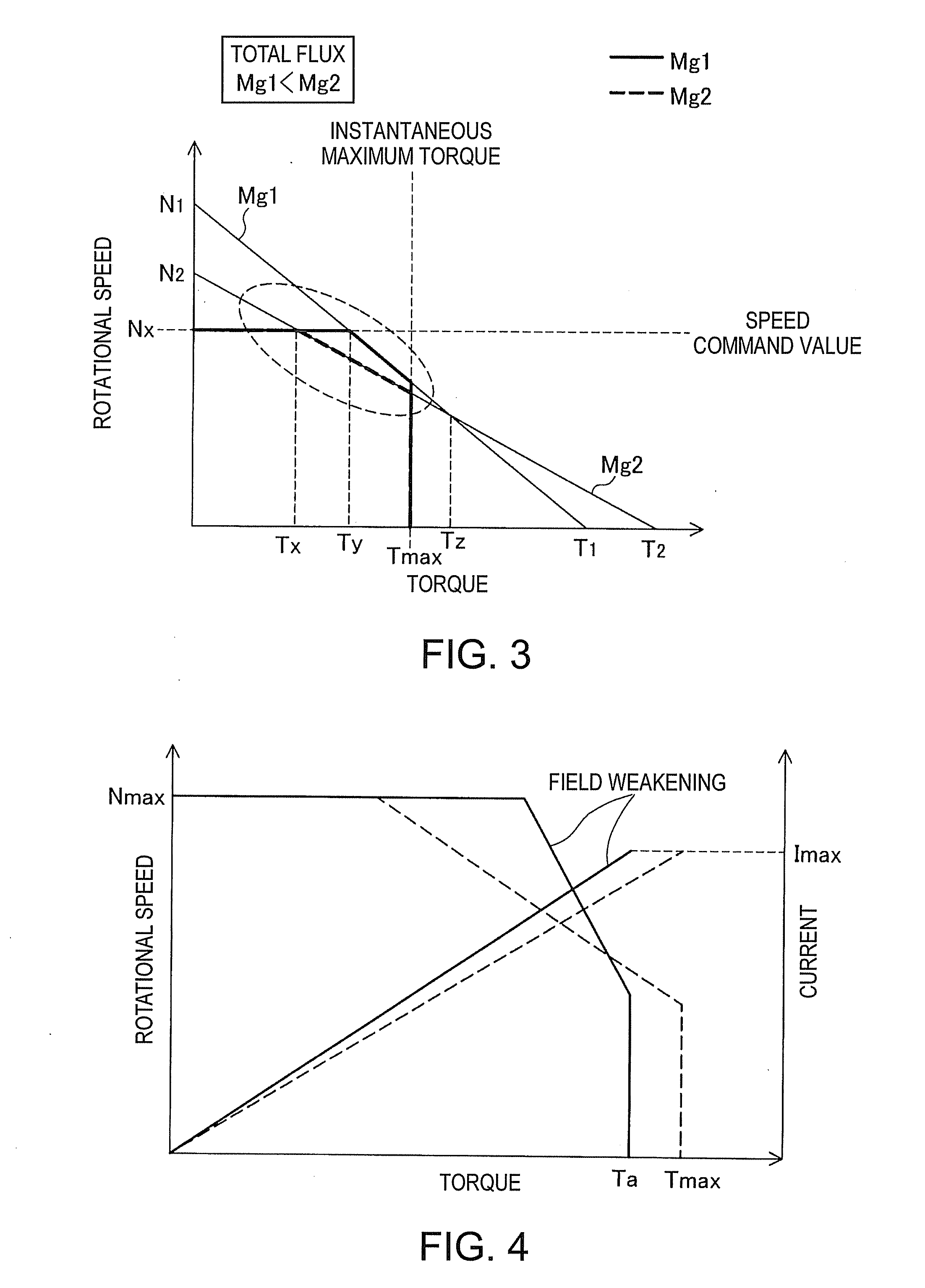Electric motor control device
- Summary
- Abstract
- Description
- Claims
- Application Information
AI Technical Summary
Benefits of technology
Problems solved by technology
Method used
Image
Examples
first embodiment
[0042]FIG. 5 is an explanatory diagram showing the T-N characteristics of an electric motor according to a first embodiment of the invention. In the first embodiment, d-axis current control is performed so that the current I does not reach the maximum current Imax until the torque T reaches the maximum torque Tmax. The drive current includes a d-axis current and a q-axis current, and in the vector control of the electric motor, the drive current is controlled by performing the feedback control based on the target values (a d-axis current command value and a q-axis current command value) of the d-axis current and the q-axis current. Taking the d-axis in the direction of the flux of the permanent magnet, the d-axis current represents the component (the excitation current component) used for generating the flux out of the drive current flowing therethrough, and the q-axis current represents the component corresponding to the load torque.
[0043]FIG. 6 is an explanatory diagram showing th...
second embodiment
[0065]FIG. 12 is an explanatory diagram showing the T-N characteristics of an electric motor according to a second embodiment of the invention. In the second embodiment, regarding the d-axis current command value Idr, the torque T is multiplied by the control gain to thereby make the d-axis current command value Idr proportional to the torque, and thus the d-axis current control is performed so that the current is not limited until the torque reaches the maximum torque Tmax set previously. Formula 8 is an arithmetic expression for calculating the d-axis current command value Idr in the second embodiment.
Idr=Kc×T (8)
[0066]In Formula 8, “Kc” denotes the control gain, and can be obtained by an experiment. Further, “T” denotes the torque of the electric motor 10.
[0067]In the second embodiment, the control of suppressing the d-axis current control value to a low level prevents the degradation of the efficiency in the low torque area or in the case of the low rotational speed where no im...
third embodiment
[0071]FIG. 13 is an explanatory diagram showing the T-N characteristics of an electric motor according to a third embodiment of the invention. In the third embodiment, as expressed by Formula 10, the d-axis current command value calculation circuit 210 calculates the q-axis current command value Iqr based on the torque command value to the electric motor 10, and then, calculates the d-axis current command value Idr by multiplying the difference (ω−ωbs) between the rotational speed ω of the electric motor and the previously determined base rotational speed ωbs of the electric motor, the q-axis current command value Iqr, and the control gain by each other.
Idr=Kd×Iqr×(ω−ωbs) (10)
[0072]In Formula 10, “Kd” denotes the control gain, and can be obtained by an experiment. It should be noted that in the present embodiment the d-axis current command value calculation circuit 210 sets the d-axis current command value Idr to zero if the torque is equal to or lower than the previously determine...
PUM
 Login to View More
Login to View More Abstract
Description
Claims
Application Information
 Login to View More
Login to View More - R&D Engineer
- R&D Manager
- IP Professional
- Industry Leading Data Capabilities
- Powerful AI technology
- Patent DNA Extraction
Browse by: Latest US Patents, China's latest patents, Technical Efficacy Thesaurus, Application Domain, Technology Topic, Popular Technical Reports.
© 2024 PatSnap. All rights reserved.Legal|Privacy policy|Modern Slavery Act Transparency Statement|Sitemap|About US| Contact US: help@patsnap.com










